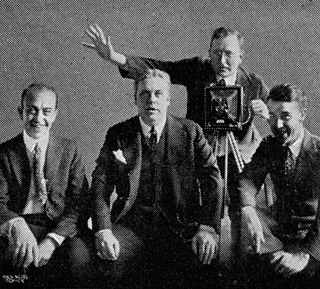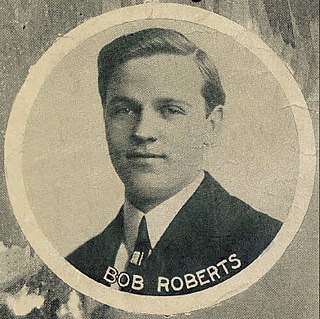Related Research Articles

Leon Bismark "Bix" Beiderbecke was an American jazz cornetist, pianist, and composer.
Ralph Sylvester Peer was an American talent scout, recording engineer, record producer and music publisher in the 1920s and 1930s. Peer pioneered field recording of music when in June 1923 he took remote recording equipment south to Atlanta, Georgia, to record regional music outside the recording studio in such places as hotel rooms, ballrooms, or empty warehouses.

Zonophone was a record label founded in 1899 in Camden, New Jersey, by Frank Seaman. The Zonophone name was not that of the company but was applied to records and machines sold by Seaman from 1899–1903. The name was acquired by Columbia Records, Victor Talking Machine Company, and finally the Gramophone Company/EMI Records. It has been used for a number of record publishing labels by these companies.

John Jean Goldkette was a jazz pianist and bandleader.

Gene Austin was an American singer and songwriter, one of the first "crooners". His recording of "My Blue Heaven" sold over five million copies and was the largest selling record of all time. His 1920s compositions "When My Sugar Walks Down the Street" and "The Lonesome Road" became pop and jazz standards.

Nathaniel Shilkret was an American composer, conductor, clarinetist, pianist, business executive, and music director.

Byron George Harlan was an American singer from Kansas, a comic minstrel singer and balladeer who often recorded with Arthur Collins. The two together were often billed as "Collins & Harlan".

The Peerless Quartet was an American vocal group that recorded in the early years of the twentieth century. They formed to record for Columbia Records, where they were credited as the Columbia Quartet or Columbia Male Quartet. From about 1907, when they began to record for record labels other than Columbia, they were more widely known as the Peerless Quartet.

Sylvester Louis "Vess" Ossman was a leading five-string banjoist and popular recording artist of the early 20th century.

The Waldorf–Astoria Orchestra was an orchestra that played primarily at the Waldorf Astoria Hotel, both the old and new locations. In addition to providing dinner music at the famous hotel, the orchestra made over 300 recordings and many radio broadcasts. It was established in the 1890s, and was directed by Carlo Curti, Joseph Knecht, at least from 1908 to 1925, later by Jack Denny and others, and then Xavier Cugat from approximately 1933 to 1949.

George Hamilton Green, Jr. was a xylophonist, composer, and cartoonist born in Omaha, Nebraska. He was born into a musical family, both his grandfather and his father being composers, arrangers, and conductors for bands in Omaha. From age four G.H. Green showed a prodigious talent as a pianist; he then took up the xylophone and by the age of eleven was being promoted as the “world’s greatest xylophonist” and was playing for crowds of 7,000-10,000. In 1915, when Green was 22 years old, a review in the United States Musician stated: "He has begun where every other xylophone player left off. His touch, his attack, his technique, and his powers of interpretation in the rendition of his solos being far different than other performers. To say his work is marvelous and wonderful would not fully express it." George Hamilton Green wrote several pieces for solo ragtime xylophone with accompaniment, as well as a xylophone method book which continues to be used by percussion pedagogues across the country. Some of his compositions for xylophone include: "Ragtime Robin", "Cross Corners", "Charleston Capers", "Rainbow Ripples", "Log Cabin Blues", "The Whistler", and "Jovial Jasper"
The McKee Orchestra and Trio was an instrumental recording group in American popular music during the 1910s.
Genesis Suite is a 1945 work for narrator, chorus and orchestra. A musical interpretation of the first eleven chapters of the Book of Genesis, the suite was a collaborative work by seven composers, some of whom wrote film music in Hollywood. The project was conceived by Nathaniel Shilkret, a noted conductor and composer of music for recording, radio and film. Shilkret wrote one of the seven pieces and invited the remaining composers to submit contributions as work-for-hire. Two giants of western twentieth-century music, Arnold Schoenberg and Igor Stravinsky wrote, respectively, the first and last parts. The Biblical text used in the spoken word narrative is the American King James Version. It was intended to be a crossover from art music to popular music.

Lucy Isabelle Marsh was an American lyric soprano who made her career as a professional recording artist for the Victor Talking Machine Company. She was an anonymous mainstay of the company, recording prodigiously from 1909 into the late 1920s. At the same time, she quickly won popular and critical recognition under her own name as a major artist on recordings for Victor.
Concerto for Trombone is a 1942 instrumental crossover work in three movements, which trombonist Tommy Dorsey, one of the best known musical entertainment stars of his time, commissioned from Nathaniel Shilkret, a noted conductor and composer of music for recording, radio and film.
Franklyn Baur was a popular tenor vocal recording artist.
"When My Sugar Walks Down the Street " is a 1920s jazz standard, written by Gene Austin, Jimmy McHugh and Irving Mills in 1924.

Robert S. Roberts, sometimes referred to as "Ragtime" Bob Roberts, was an American novelty singer and ragtime song composer in the early years of the 20th century.

Frederick W. Hager was a musician, recording artist, composer, and music director active in the United States between 1895 and 1923.
References
- 1 2 Gracyk, Tim; with Frank Hoffman, Popular American Recording Pioneers: 1895–1925, Haworth Press, New York, 2000, pps. 153, 227–229, 299, 349. ISBN 0-7890-1220-0
- 1 2
- ↑ Shilkret, Nathaniel, ed. Shell, Niel and Barbara Shilkret, Nathaniel Shilkret: Sixty Years in the Music Business, Scarecrow Press, Lanham, Maryland, 2005, p.36, 47 and 95. ISBN 0-8108-5128-8
- ↑ Sudhalter, Richard, Lost Chords: White Musicians and Their Contribution to Jazz, 1915--1945, Oxford, New York, 1999, p. 313. ISBN 0-19-505585-3
- ↑ Victor Recording Book log, pp. 5245, 5247, 5215, 5257, 5259, 5262, 5322, and 5328.
- ↑ "Edward T. King Returns to Columbia Phonograph Co.," Talking Machine World Vol. 22, No. 11, November 15, 1926, p. 42